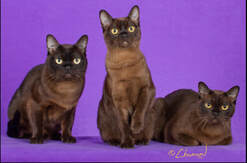The History of the Burmese cat

The Burmese breed is an old, Malayan cat breed noted for its rich chocolate brown colored coat and captivating gold - not yellow, not green eyes. Burmese cats have long been honored as being one of the best companion cat breeds, noted for their intelligence, playfulness and amicable disposition.
In describing Burmese cats, the catchword is "ROUND". Nearly every part of the Burmese standard includes the word "round".
Burmese cats have compact, muscular bodies with rounded heads. One show judge described them as "a silken sack of oats". The Burmese head should be nicely rounded, without flat planes whether seen from the front or in profile. Faces should be full, with considerable breadth between the eyes, tapering slightly to a short, broad, well developed muzzle. From the side, there should be a distinct nose break. Ears are medium in size sitting well apart on the rounded head. Ears should tilt slightly to the front, and be broad at the base and rounded at the tips. Burmese eyes are also rounded, and must be gold. Green, blue or yellow eyes are disqualifying traits.
The Burmese breed is highly intelligent and almost dog-like in their tendency to shadow their human companions, taking great interest in all aspects of daily life. Bred for companionship, not service, most of the natural survival instincts have been lost in the Burmese breed making them vulnerable to the hazards of outside living.
In America, Burmese cats come in four colorations. Sable, the rich walnut - chocolate brown is the primary color. Champagne Burmese are colored like a rich cup of cocoa with darker sable "points" - masks covering the face and ear tips, paws and tails. Blue Burmese are a cool, steely gray while Platinum Burmese are a pale gray, with slightly darker gray "points" - looking very much like living chrome. Burmese on the world stage have additional colors to their palette - reds, tortoise and creams. Despite the difference in colors, all Burmese are alike in body and heart - happiest when with their human family. Playfulness begins at an early age and stays with the Burmese throughout their lives. They are curious - eager for anything new and interesting. They get along well with other animals. If you are ready for not just a pet, but for a furry best friend - then you are ready for a Burmese cat.
There are some things a Burmese buyer needs to know. As in all breeds, there is a genetic weakness in some lines of the Burmese breed causing severe head and skeletal defects. Dwarfism is also a trait being combated by Burmese breeders. These defects are alarming and when detected, the producing animal(s) and their kittens should be altered and not used in the breeding program.
This is a guarantee from this Traditional breeder to you. Traditional Burmese Cattery will not use cats with these genetic traits in our breeding program, ensuring complete general health for all of our Burmese family.
In describing Burmese cats, the catchword is "ROUND". Nearly every part of the Burmese standard includes the word "round".
Burmese cats have compact, muscular bodies with rounded heads. One show judge described them as "a silken sack of oats". The Burmese head should be nicely rounded, without flat planes whether seen from the front or in profile. Faces should be full, with considerable breadth between the eyes, tapering slightly to a short, broad, well developed muzzle. From the side, there should be a distinct nose break. Ears are medium in size sitting well apart on the rounded head. Ears should tilt slightly to the front, and be broad at the base and rounded at the tips. Burmese eyes are also rounded, and must be gold. Green, blue or yellow eyes are disqualifying traits.
The Burmese breed is highly intelligent and almost dog-like in their tendency to shadow their human companions, taking great interest in all aspects of daily life. Bred for companionship, not service, most of the natural survival instincts have been lost in the Burmese breed making them vulnerable to the hazards of outside living.
In America, Burmese cats come in four colorations. Sable, the rich walnut - chocolate brown is the primary color. Champagne Burmese are colored like a rich cup of cocoa with darker sable "points" - masks covering the face and ear tips, paws and tails. Blue Burmese are a cool, steely gray while Platinum Burmese are a pale gray, with slightly darker gray "points" - looking very much like living chrome. Burmese on the world stage have additional colors to their palette - reds, tortoise and creams. Despite the difference in colors, all Burmese are alike in body and heart - happiest when with their human family. Playfulness begins at an early age and stays with the Burmese throughout their lives. They are curious - eager for anything new and interesting. They get along well with other animals. If you are ready for not just a pet, but for a furry best friend - then you are ready for a Burmese cat.
There are some things a Burmese buyer needs to know. As in all breeds, there is a genetic weakness in some lines of the Burmese breed causing severe head and skeletal defects. Dwarfism is also a trait being combated by Burmese breeders. These defects are alarming and when detected, the producing animal(s) and their kittens should be altered and not used in the breeding program.
This is a guarantee from this Traditional breeder to you. Traditional Burmese Cattery will not use cats with these genetic traits in our breeding program, ensuring complete general health for all of our Burmese family.